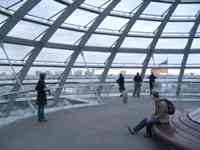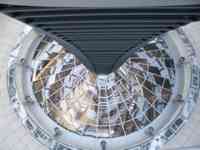Europe 2006, Berlin
Here is my narrative about my trip to Europe in October 2006.
Parts
Monday, October 23
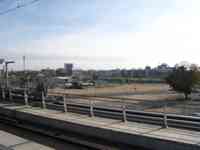 |
| First view of Berlin. |
I took a morning train to Berlin, and here is my first view of the city. The
dome on the right is the parliament building, and the tower in the left is the
television tower.
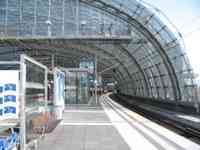 |
| Platform at top of Hauptbahnhof. |
I am in the new Hauptbahnhof (just opened a few months before), and it
is big. The image on the right shows the track I just disembarked onto. It is
is on the fourth floor of the Hauptbahnhof. Or maybe it was the fifth.
 |
| Hauptbahnhof interior. |
Here is the inside of the Hauptbahnhof. The top floor has tracks; the
middle three floors have travel services, shops, entrances and exits to the
street; and the bottom floor has more tracks. The top and bottom tracks are
perpendicular, and there are elevators where the platforms intersect (as seen
from above), so you can go directly from one of the lower platforms to one of
the upper platforms.
At the Hauptbahnhof, I bought a Berlin Welcome card. (Or it may be
called the City Tour Card. Whatever, you can buy it in the S-Bahn office.) As I
mentioned earlier, just get the standard card that covers only transit. Skip
the premium version.
I made my way to my hotel. That was not hard; using public transit is generally
easy in Europe. However, it is not seamless in Berlin. You have to go outside
to transfer from the U-Bahn to the S-Bahn, they need more and better signs, and
some of the walks are too long (but not as bad as Stalingrad in Paris).
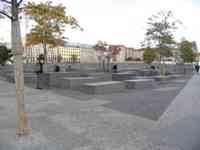 |
| Holocaust memorial. |
I found my hotel, checked in, and headed back out. Since it was near the hotel,
I walked down Kurfürstendamm, a main shopping street. My first purchase was
from Leysieffer, a chocolatier chain. My second was at the Hard Rock Cafe, to
add another shot glass to Cathleen’s collection.
I was headed for Brandenburger Tor when I happened across the new Holocaust
memorial, Memorial to the
Murdered Jews of Europe. (Memorials for other victims are also being
built.) This was not in my plans because my guide book made little mention of
it, saying it was under construction. However, it had been completed.
 |
| An aisle with uneven ground. |
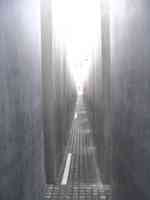 |
| Inside Holocaust memorial. |
This was the most effective and affective memorial I have experienced. It
consists of 2,711 blocks placed on uneven ground. The number of blocks has no
particular meaning; it is just how the work turned out in the space. I walked
through the memorial, and there is an overpowering feeling there. For one
thing, the blocks are uneven, so they do not merge into an anonymous array;
they remain individuals. The ground goes up and down through the memorial, so
you do not simply walk straight through it. The blocks appear shallow at the
edges, but the ground is low in the center, so a few seconds’ walk
immerses you inside the memorial. The blocks rise above your head, and the sun
is blocked out. There are no words; it is just feelings. The memorial fills an
entire city block. You can see how large it is from the
satellite view.
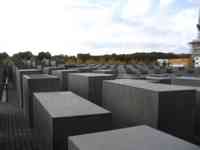 |
| Irregular slabs. |
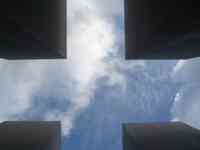 |
| View of sky from inside Holocaust memorial. |
The view from the street, seen in the first image, is deceptive. Inside, the
columns are tall, imposing, and solemn. The ground is deep and irregular, and
it is very moving to walk through. The irregularity in the ground and in the
block sizes breaks up the rows, so the blocks have some individuality, and you
see many blocks, not just one array. That gives some effect to the number of
blocks.
There is more information in
Wikipedia.
There is a museum underground. There was a long line to get in, and I was there
near closing time, so I came back another day.
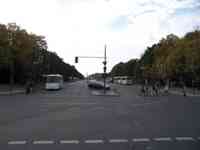 |
| Straße Des 17 Juni. |
Here is a view from Brandenburger Tor looking down Straße Des 17 Juni,
June 17th Street. (The street commemorates the uprising of East Berliners on
June 17, 1953.)
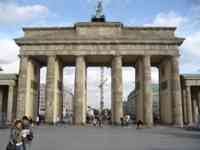 |
| Brandenburger Tor. |
To the right is Brandenburger Tor. I bought some pieces of the Berlin Wall
here, for souvenirs and gifts. They were in the package that never arrived
home, so they are gone.
 |
| Berlin Wall marker. |
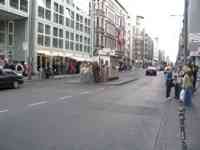 |
| “Checkpoint Charlie.” |
Almost all of the Berlin Wall was torn down, and it is being replaced by
markers (far left image) showing where it was.
At near left is a fake Checkpoint Charlie, maintained in the original location
for tourists.
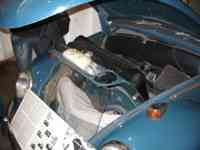 |
| Berlin Wall museum. |
Here is an exhibit in the Berlin Wall Museum that I photographed before they
told me photographs were not allowed. The museum is good but repetitive. The
same text appears in multiple places. Also, it is scattered; the museum does
not present a cohesive story.
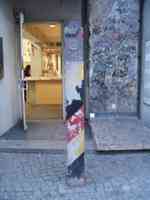 |
| Berlin Wall segment. |
A segment of the wall the museum snagged is shown on the right. The museum may
have been founded by activists and earnest people who sacrificed to help rescue
people while the wall was up, but I think it is a profit-making enterprise now.
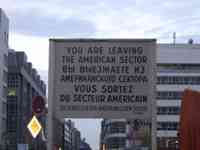 |
| Leaving sector. |
Here is another thing maintained for tourists, the sign indicator the sector
border.
Unlike Essen’s two-way escalators, the escalators in Berlin are mostly
one-way. And I observed they were mostly the wrong way, at least in the U-Bahn.
That is puzzling because I am pretty sure I exited the U-Bahn as often as I
entered it. I did not count, though.
Another thing I noticed in Berlin is that when I asked questions in German,
people more frequently answered me in German rather than switching to English.
In 2003, they used to answer mostly in English. That may be a sign my German
has gotten a little better.
It was getting a bit late, and I headed south to find International Veld
Schokoladen, a chocolate store. I bought a few things, nothing spectacular. One
was a bar with Sandborn berries. Or maybe it is Sanborn. Googling either of
those does not turn up anything relevant, so I do not know what they are called
in English.
I finished the day at Amrit, a good Indian restaurant not far from Veld.
Tuesday, October 24
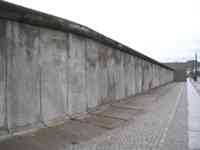 |
| Berlin Wall Memorial. |
In the morning, I went to the Berlin Wall Memorial, north of the city. There is
a part of the wall in its original location and a museum/information building.
The wall went through several generations, being remade over the years, so this
is of course the last generation, the fourth generation in 1975.
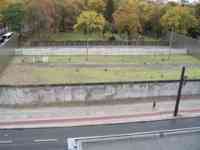 |
| Berlin Wall Memorial. |
 |
| View through Berlin Wall. |
The near-right photograph is taken through a crack on the East German side of
the wall, showing a view people there would have had. The “wall” is
actually a wall, an empty zone, and another wall.
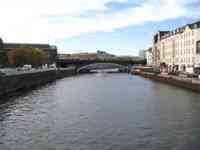 |
| Train crossing the Spree. |
 |
| Boat on the Spree. |
I went back to the center of Berlin for more tourist things. Here is the
Spree river.
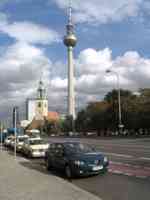 |
| Fernsehturm. |
On the right is the Fernsehturm (television tower), which is a tourist
draw. I do not see much reason to be interested in the tower, except there is a
few of Berlin from the top. There was a long line of people waiting to get in,
so I left and came back at opening time the next day.
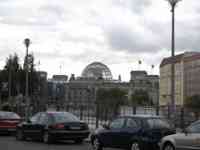 |
| Bundestag. |
Here is the Bundestag, the German parliament building. The dome is a landmark
seen in most newscasts from Berlin. It is open to the public but, like the
television tower, there was a long line. I checked my guidebook for the opening
hours and planned to come back. Fortunately, the opening times of the Bundestag
and the television tower are staggered, so I was able to get to the opening of
each one the next morning.
 |
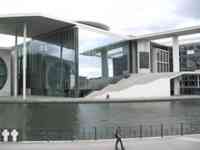 |
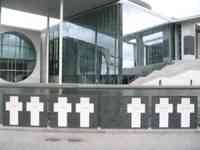 |
| Parliament buildings and memorials to victims of the Berlin Wall. |
The parliament includes some other buildings with nice architecture for
government buildings.
I spent a while in Deutsches Historisches Museum (German History Museum), which
is newly opened or reopened or something, but I do not have any photographs
for you, sorry.
 |
| Gaststätte Zum Nussbaum. |
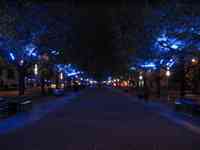 |
| Unter Den Linden. |
I had dinner in Gaststätte Zum Nussbaum, which is Berlin’s oldest
restaurant (as a business; the building is new). It opened in 1571.
Unter Den Linden street is lit up. Unter Den Linden means under the
Linden trees.
 |
| Back of Brandenburger Tor. |
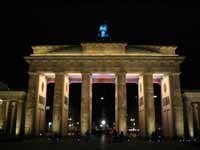 |
| Front of Brandenburger Tor. |
Brandenburger Tor is at the end of Unter Den Linden, and it is also lit up. In
Passport to Europe, a Travel Channel show, Samantha Brown said the top
of Brandenburger Tor was destroyed (in World War II?) and remade from the
original mold. I cannot find corroboration of that, though.
Wednesday, October 25
So, it is morning, and I was in the first batch of people in the dome.
 |
| Inside the Bundestag dome. |
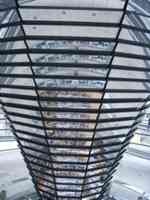 |
| Lots of mirrors. |
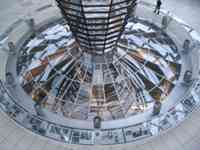 |
| Looking down into the chamber. |
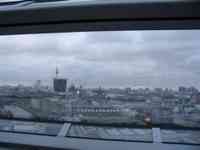 |
| Fernsehturm area. |
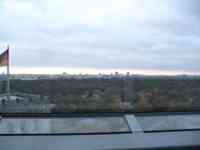 |
| Tiergarten. |
Here are two views from inside the Bundestag. The near right is a view of the
Tiergarten (southwest), a large park in Berlin. The far right looks over
to the Fernsehturm (southeast).
Below are several views inside the dome.
 |
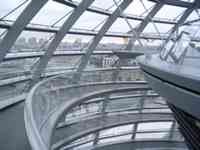 |
| Views inside the Bundestag dome. |
The seats down there are where parliamentarians sit.
Below are views from the roof. The first two are the Tiergarten and the
Fernsehturm again. The third is the Hauptbahnhof. On the right
side, you can see the end of the building, and there are some white spots that
are signs or something that I think are roughly people-size. That gives you an
idea how big the building is.
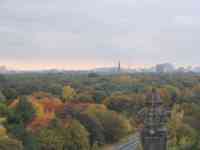 |
 |
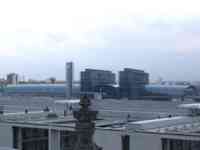 |
| Tiergarten. |
Fernsehturm area. |
Hauptbahnhof. |
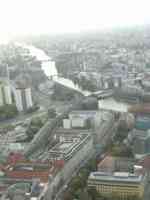 |
| Berlin from Fernsehturm. |
 |
| Nicolai quarter. |
Next, I crossed town and was in the first batch of people up the television
tower. At near right is a view of the Nicolai quarter, which is the oldest part
of Berlin, where its markets and gathering places started, in the 1100s (more
than a century after Ulm was established). The area was razed in World War II,
though, so these buildings are reconstructions. The far right view is to the
southeast.
|
Primo Levi: “It happened, therefore it can happen again.”
|
I visited the museum at the Holocaust memorial. It is a good museum. Among the
exhibits are fifteen personal stories, which are compelling.
The museum has a database of Holocaust memorials. The map showed something near
Ulm, so I looked into that and found there are two memorials in Ulm. One is an
exhibit in the Volkshochschule where I studied German. Another is in an
old fort outside of town. I made notes to visit both when I went to Ulm.
 |
| Berlin Wall segment in Potsdamer Platz. |
This is a segment of the Berlin Wall at Potsdamer Platz, which is a primary
meeting place of former East Berlin and former West Berlin. Major
reconstruction has made the intersection a showpiece of reunification.
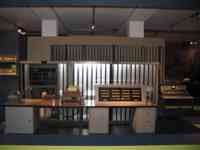 |
| Zuse Z23. |
I went to Deutsches Technikmuseum, the German technology museum. On the right
is the Zuse Z23. Zuse was an early computer pioneer. This specific one was
delivered in 1962, but the Z23 model dates from 1960. The Z23 was
backward-compatible with the Z22.
The museum also had a Z1 on display, but I think it was recreated, and it was
encased in some box that was mostly transparent but still reflected too much
light to take a flash photograph of it. (Somebody got
a good
picture, though.)
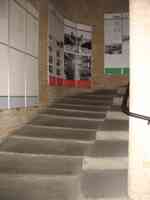 |
| Horse staircase. |
This is a spiral staircase for horses.
 |
| Locomotive. |
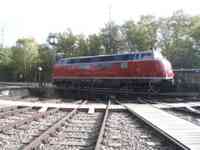 |
| Turntable. |
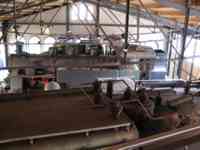 |
| Trains. |
I was not impressed with most of the museum, but they seem to have a good
collection of trains.
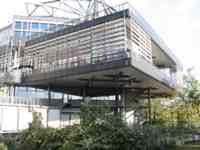 |
| Technology Museum. |
 |
| Boat. |
There were lots of boats too.
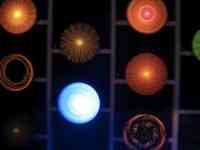 |
| Spinning lights. |
At another building, the museum has the Spectrum, which I think is trying to be
like San Francisco’s excellent
Exploratorium. However, it does not
do as good a job—too many flashing lights or other entertainments and not
enough hands-on science. I even saw one exhibit that seemed to be inspired by
one of my favorite Exploratorium exhibits, a demonstration of the effect of
eddy currents in a magnetic field, but the Spectrum’s version was much
weaker.
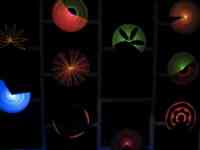 |
| Are you learning anything? |
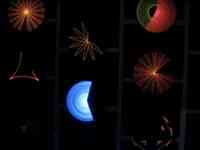 |
| More spinning lights. |
At the Exploratorium, there is a strong horseshoe-shaped magnet and several
disks. When you put a normal conductive disk between the poles and pull it out,
you can feel quite a bit of resistance. The movement of the disk in the
magnetic field causes an electric current which causes its own magnetic field.
The exhibit has other disks to try, including one with radial slots cut into
the disk, and that one is much easier to pull out, because the currents cannot
flow around the disk. Another disk is nonconductive, so you feel no force when
pulling it out.
It is a great exhibit; you get a direct feel for the force. At the Spectrum,
their version is weaker and is indirect—as I recall, you do not pull on
the disk directly, but only watch as it drops or something. (Unfortunately, I
am writing this several months later and do not recall the details.)
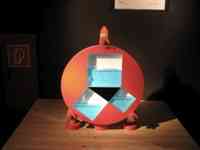 |
| Demonstration of Pythagorean Theorem. |
This is a good exhibit. It demonstrates the Pythagorean Theorem. You can see
the water flow from the square tank by the hypoteneuse to the other two tanks,
showing the amount of water is the same.
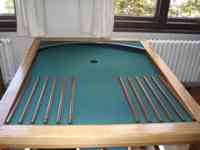 |
| Hyperbolic pool table. |
I named the image at the right Elliptical Pool, but it is actually
hyperbolic. A ball rolling along any of the lines will be bounced into the
pocket.
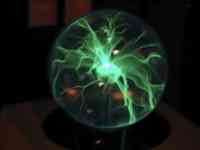 |
| Short exposure. |
 |
| Long exposure. |
The sphere is just eye candy, but I played with the camera to get a quick
exposure and a several-second exposure.
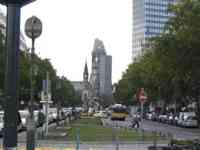 |
| Wilhelm Memorial Church and “Berlin” sculpture. |
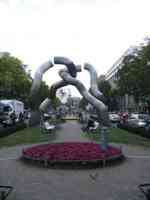 |
| “Berlin.” |
On the left is a view down Tauenzienstraße. The church is Kaiser Wilhelm
Gedächtniskirche (Emperor Wilhelm Memorial Church). It was damaged in World War
II and deliberately left not fully repaired. Nearby is Kaufhaus des Westens (KaDeWe), shop of the West, which I hear is the
biggest department store on the continent. The top floor has a good selection
of chocolates from several chocolatiers.
At right is the “Berlin” sculpture, on Tauentzienstraße. It was
designed for the city’s 750th anniversary in 1987. Its two
halves are very close but do not connect.
Incidentally, while riding around in Essen and Berlin, my ticket was checked
three times in Essen and twice in Berlin. That is more than the entire nine
months I lived in Ulm.
I visited a couple of chocolate stores and KaDeWe, that huge department store.
Actually, I visited a number of chocolate stores while I was in Berlin, but I
will just tell you about the highlights. Nibs Cacao was hard to find. I was
walking along the correct street looking for the address, and I was surprise to
find the building numbers went up one side of the street and down the other,
instead of alternating even and odd across the street. I do not recall seeing
that before. Nibs Cacao sells fancy hot chocolate drinks, like a chocolate
Starbucks. They also have some pralines, which I definitely recommend.
Another interesting store is Confiserie Melanie. They are on their own path,
with flavors such as Knoblauch, Spargel, and Saffron. That
is garlic, asparagus, and saffron. I cannot say whether you will like the white
chocolate and garlic truffle, but it was well done.
KaDeWe retails many finite chocolatiers, including Lênotre, Neuhaus, Valrhona,
Teuscher, Godiva, Niederegger, and Fassbaum & Rausch. The patisserie and
gourmet foods are on the sixth floor, so just get in the elevator when you
enter.
Later, I noticed two streets, one in Ulm and one in Neu-Ulm, where the building
numbers were non-sequential—not just skipping some numbers but out of
order.
That wrapped up Berlin, and Ulm was next. I saved the best for last!
© Copyright 2007 by
Eric Postpischil.



































